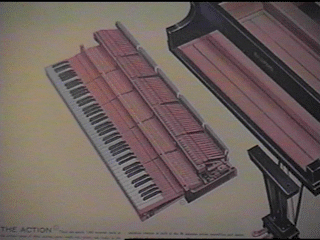
There are nearly 7,000 separate parts in the action, most of them moving parts. Each one is poised and ready to perform its specialized function as precisely as the mechanism of a fine watch. Not only must the action transform the touch of a key into the blow of a hammer with nerve quick ability, but the impact of the hammer must be in direct proportion to the force of the pianist's fingers on the keys. Having struck this blow, the hammer must free itself from contact with the string before the first vibration cycle is complete. It is humanly impossible to play a note faster than the action can respond. Such response demands an action which is light, vibration proof and virtually everlasting. Such agility requires bushings which can never be loose and must never be tight. The moving parts of the action are pivoted on nickel silver center pins surrounded by all wool cloth bushings, shrunk around a wire a fraction of an inch larger than the pins. The pressure against the center pin is never sufficient to cause appreciable wear on the cloth bushing, but it is always enough to cling gently to the pin and permit free, easy, and noiseless movement. Elaborate seasoning and drying procedures guarantee uniform moisture content in each of the 88 separate action assemblies and assure a perfect balance from note to note. Dampers, activated by the pedals, permit the performer to sustain a note after the key is released or to dampen its vibration before the next note is played. Today's pianos have 67 separate felt dampers resting against its strings. When a key is struck, the damper rises, allowing the string to vibrate. When both the key and the pedal are released, the damper returns to the string. Two pedals control the dampers. The right pedal (Sustain pedal) permits all the strings to vibrate until the tone dies away or until the pedal is released. The middle pedal (Sostenuto pedal) preserves only those notes which are played as the pedal is depressed, while each succeeding note still sings out clearly and crisply, independent of the sustained chord.
The left pedal (Soft pedal) shifts the entire action over so that the hammer strikes only two of the three treble string notes and one of the two strings in the bass section creating a dramatic transition from Forte (loud) to Piano (soft).